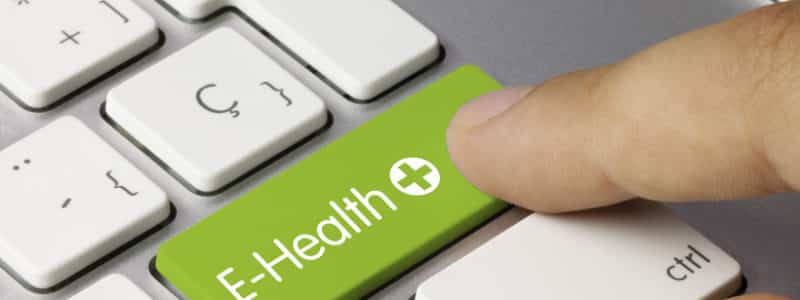eHealth initiatives make up a world wide trend. The related eHealth technology, the eHealth forums, and eHealth social media is confirming this trend. Although there is no single unanimous definition, the eHealth initiative can be thought of as the incorporation of technology in healthcare through many forms.
eHealth initiative, some examples
While the eHealth initiative includes an endless list of possibilities, the following is a short list of examples to help ponder the potential variety.
- Electronic Health Records: the collection of a patient’s health record into a digital format; can be easily shared amongst providers
- Telemedicine: providing patients medical care from a distance through video, telephone, or even robotic technologies, overcoming distance barriers in the ICU, home care or rural settings
- Remote monitoring: technology that allows physicians and hospitals to monitor or receive reporting of patient vital signs, scores on self-administered questionnaires, and other similar techniques that facilitate closer supervision of at-risk patients
- Mobile health: healthcare recommendations through the use of a mobile phone, tablet, or computer e.g. self-monitoring blood glucose apps, usage of health apps
- Multidisciplinary case discussions and case management between professionals or between professionals and their patients
- Safe exchange of data and information by communicating through secure online messaging and video connections
- Open, social media based, ePatient conversations between stakeholders, eHealth forums and similar eHealth initiatives
The eHealth initiative is a configuration of several different applications that requires tailoring to each situation and demand. For this reason, the development of eHealth technology requires a step by step approach. Three firm principles are often expressed to guide the development and implementation of eHealth:
- the concepts of integrated care,
- multidisciplinary care, and most of all
- patient empowerment.
In short, any eHealth initiative should be conducted with the patient’s active involvement, should integrate a balanced view of the disciplines providing care, like medical specialists and primary care providers, pharmacists, imaging centers, etc., and should lead to transparent and efficient medical, logistic, and organizational processes and activities.
What are current eHealth Initiatives?
As healthcare providers and authorities become more worried about the quality and cost of medical care, eHealth initiatives are often seen as a part of the solution. In its various applications, the eHealth initiative might indeed do the seemingly impossible: enhance quality, enlarge the potential of patient volume, and reduce costs. eHealth technologies allow health care providers to optimize utilization of patients’ data in medical decision making processes, and give more support and guidance for patients in their self-care. It can facilitate care processes logistically and administratively. These features will make the eHealth initiative one of the dominant trends in the future.
Patients tend to acquire knowledge actively and use all kinds of medical, health apps, and social media, such as Twitter, Facebook, or Google searches, already. They like to learn about their conditions and press for access to their data. Patients have, and will continue, to expect an accommodating attitude from their consulting professionals for eHealth trends.
Electronic sharing of healthcare data and patient information to make care and treatment more timely and effective is an expected outcome of the eHealth initiatives. Telemedicine is likely going to be one “clinical” part of a more fully developed eHealth system, adding the stakeholder, patient and medical provider or hospital and clinic facility, to the mix. And just see the explosive growth of patients using social media to discuss and disclose – sometimes very personal – health information (PHI), with HIPAA protections all but ignored. In contrast, eHealth initiative based professional services are expected to be available in a HIPAA compliant version – somehow.
Countries all over the world have begun incorporating eHealth initiatives into their healthcare systems. Denmark, for example, has a nation wide eHealth technology system. Every citizen has a personal webpage where he/she can confidentially log-in and monitor their treatment and diagnoses, manage appointments and communicate with physicians, keep track of medication compliance, and order medication from pharmacies. In the U.S., patient portals of EHR systems allow two-way communication between physicians and patients on results of visits, testing, medication refills and general questions about conditions and diagnoses.
What are the main features of eHealth Initiatives?
In essence, eHealth initiatives involve three fundamental features to facilitate care for better outcomes, predominantly by online and digital technologies:
- to optimize the use of data in medical decision making by adequate electronic monitoring, registration, and storage of patient data, (accessible by all participants directly involved in the healthcare process);
- to connect and link these participants to each other in their activities in providing healthcare;
- to inform, guide, and support these participants in the decision making of the healthcare and self-care of patients.
Why should we pay attention to eHealth?
As eHealth technology becomes more advanced, more and more people have access to the knowledge of the world at their fingertips. Many people are already using health apps on their smartphones or the internet to help diagnose a personal or ones’ loved ones condition. Doctors running trials all over the world are seeing a decrease in patient admissions where telemonitoring is a regular occurrence, and an increase in medication compliance. Without a doubt, the eHealth initiative is a big part of the future of modern medicine.

